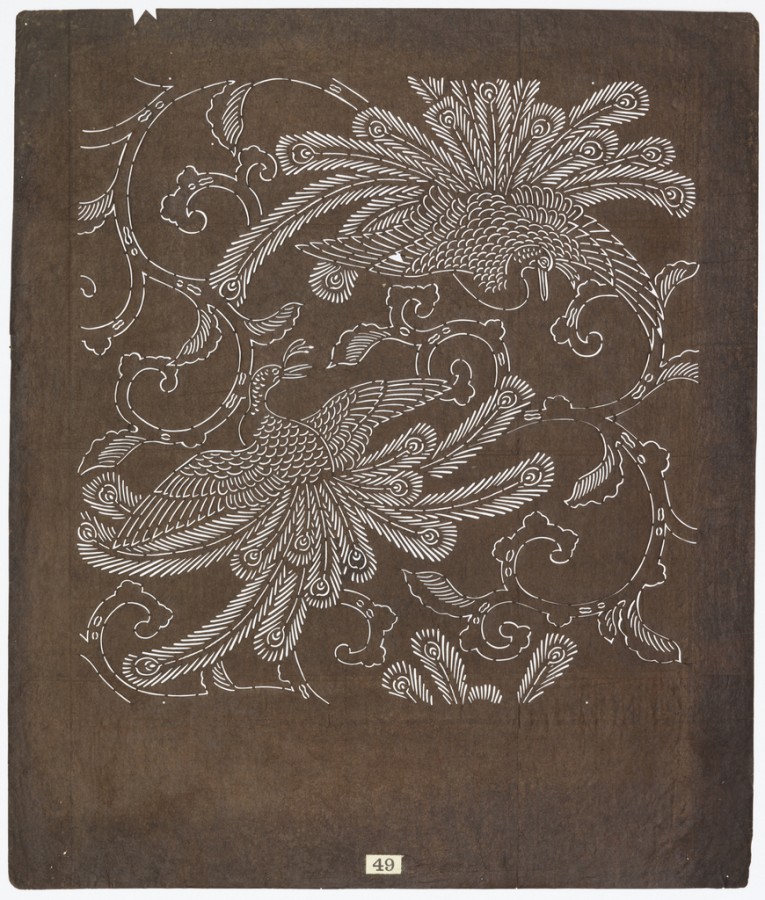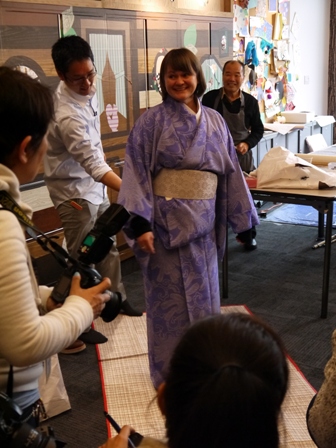On March 16th, Cooper-Hewitt, National Design Museum hosted a fascinating demonstration of the process of a traditional form of Japanese stencil carving (katagami) and its use in the technique of resist-dyeing textiles (katazome) at the Cooper-Hewitt Design Center in Harlem.
The event had its origins in a visit that Yuki Ikuta, Assistant Curator of the Mie Prefectural Art Museum in Japan, made to Cooper-Hewitt in the fall of 2012 to research the museum’s collection of katagami. With nearly 400 stencils in our collection, Cooper-Hewitt has one of the largest and most significant holdings of katagami in the United States. Ms. Ikuta had chosen to visit Cooper-Hewitt at the suggestion of Master katazome dyer Masao Aida, who has been practicing his craft for over fifty years and had spoken to Ms. Ikuta about the exceptional beauty of the katagami in the museum’s collection.
Isao Uchida, a Master katagami carver who has been producing stencils for the past 48 years, together with Ms. Ikuta and Mr. Aida, selected a sheet of katagami from Cooper-Hewitt’s collection to reproduce for the demonstration.

Katagami: Two Peacocks, late 19th-early 20th century. Cooper-Hewitt, National Design Museum, Smithsonian Institution, Gift of Helen Snyder. 1976-103-241. Photo: Matt Flynn © Smithsonian Institution.
For Mr. Uchida, who carved the image of the two peacocks, it was both an opportunity to trace the work of a Master craftsman from nearly a century earlier as well as to bring his own interpretation to the depiction. Mr. Uchida told the audience that he wanted them to feel as if the peacocks would take flight from the printed silk at any moment. This was no small task—before coming to New York, Mr. Uchida spent three days carving the single stencil that was used in the Cooper-Hewitt’s demonstration.
Over the course of two hours, Mr. Uchida demonstrated his technique for carving, while Masao Aida, with the help of his apprentice Airo Aida, who has already trained for more than ten years, showed visitors the elaborate process of transforming a white piece of silk into a vibrantly-colored and ornately-patterned textile.
In addition to producing the repeating-peacock pattern, Mr. Aida demonstrated his personal technique for producing a moiré effect through dyeing silk. This technique is Mr. Aida’s trademark, and it has its roots in a memory from his youth. Visitors to the demonstration were captivated as Mr. Aida recalled being woken from a nap by his mother while he was still a teenager. When his mother informed him that it was time to get back to work, the young Mr. Aida opened his eyes to see the bright light filtering into the room between the slats of his bamboo shades, producing the delicate moiré or rippled appearance. To this day, Mr. Aida’s moiré-patterned scarves and kimonos are sought after throughout Japan. An example can be found in Cooper-Hewitt’s collection.
At the end of the demonstration, the four members of the group presented Cooper-Hewitt with a stunning surprise gift of a completed kimono featuring the peacock pattern, beautifully modeled by a member of our Education team, Sarah Freeman! The lyrical kimono was the culmination of weeks of laborious work by these master craftsmen. The color—a rich, pale purple—was personally selected by Mr. Aida because he believes that each person exudes their own individual color, and this purple struck him as being particularly American.

The museum’s 1979 publication about some of its katagami can be viewed online here. A small selection of Cooper-Hewitt’s katagami stencils can also be seen on our collection database.